While some will enjoy the challenge and the beauty of camping in winter, for others it may be a case of physical and mental endurance.
Winter camping is very different to tent life in the gentler seasons and, if you havenít done it before there are a few pointers to avoiding pitfalls and making the experience a pleasure rather than a pain.
This page will assume that you have enough of the right type of clothes for your trip but you will probably want to pack at least one extra pair of fleece or silk gloves to wear in camp, which will keep your hands from freezing but be thin enough to allow you to cook and do other tasks in and around the tent.
And do take a book (or an e-reader) and extra torch batteries: Scottish winter nights in a tent can be very long.
(All photographs and additional advice on this page courtesy of Chris Townsend)
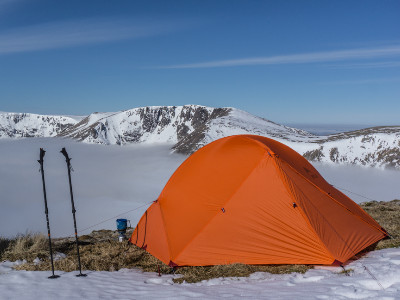
Budget tents, or tents which prioritise lightness over robustness, are best left for the summer months. For winter, a tent should be able to stand up to severe gales, and be proof against any sort of weather, including heavy, drifting snow or torrential, wind-driven rain. If you are already experienced at wild camping in the summer months you may well have an idea of the type of tent you will need; if not, then seek advice before you buy.
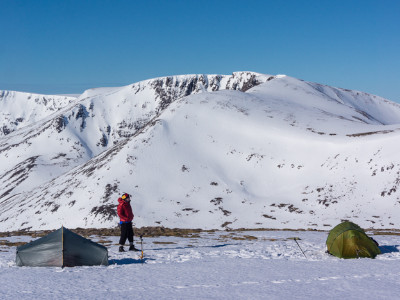
Thereís a fashion for hilltop camps, and thereís no denying they can enable you to take some great photos, but in winter it is best to stay low Ė at least until you have gained a considerable degree of experience.
Consider your pitch carefully: although a sheltered spot will protect your tent, if heavy snow is forecast you should avoid hollows or close to the lee of rocks or walls where the snow may drift deeply. Low, sheltered locations may also be prone to flooding if heavy rain or a rise in temperature and snow melt is forecast Ė pick your pitch carefully above any flood potential.
If there is light snow cover then itís best to clear a patch of bare ground for the tent, but if the snow is deep just tramp it down until you get a firm surface. Make this as smooth as you can: bumps will stay.
Whatever you do, do make sure you have the tent pegged down securely. Long wide pegs are best for snow Ė in soft snow bury pegs horizontally with the guyline round the middle and stamp them in place. If you have any doubts about security, you can reinforce windward guying points with ice axes/split walking poles or even a stuff sack filled with snow and buried.
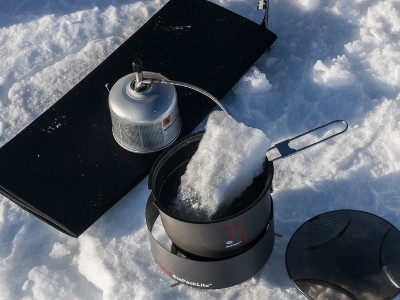
When the temperature is sub-zero it may be hard to find water that isnít frozen, with small streams turned to solid ice. Even where you can break through ice on bigger streams and rivers the water you get can freeze in your water bottle. Narrow-necked bottles are bad for this.
Find liquid water if you can. If there is none, then ice is easier to melt on your stove than snow Ė but be careful, as sometimes getting to ice or water can be dangerous. If thatís the case then use snow, but make sure itís only snow you put in the mess tin.
If you want to keep water for future use then youíll have to find some way to stop it from refreezing, which might even mean using a thermos flask. Your own body heat will work but remember itís more important to keep yourself warm.
Top Tip: Fill your thermos with boiling water last thing at night, it provides a great Ďstarterí for your snow melt in the morning for breakfast. If you have no thermos, then fill a pan with water Ė itíll freeze but can be melted on the stove. You canít thaw ice in water bottles.
Donít hang about once you have your tent up. Fetch water for the night if any is available (If everything is frozen chip out a supply of ice Ė youíll need more than you think.) and get your sleeping mat and sleeping bag rolled out and everything arranged inside your tent. If the temperature is particularly low you may want to get straight into your sleeping bag Ė itís far easier to stay warm than it is to get chilled and then have to warm up.
Take off your shell layer and boots. If itís not too cold you can leave both in the tent porch overnight, but if the temperature is below zero itís best to put them in a dry-bag or polythene bag and keep them inside the tent Ė frozen boots can be all but impossible to put on in the morning. (Keep boots off the ground, on top of your pack say, if possible.) Do the same with any damp/wet clothes you are wearing and change into the dry spare clothes you are carrying. Itís surprising how a base layer worn all day may feel dry, but when exercise stops, the moisture in your thermals will soon sap your body heat. It will be horrible to put the damp/wet clothes back on in the morning, but youíll have spent the night dry and warm and be better prepared for the next day.
Tip: When you take your dry clothes from the drybag they're kept in, turn it inside out before you put the day's wet/damp clothes inside. That means the inside of the bag will still be dry when you repack your spare clothes in the morning.
If the weather is wet or snowy, keep your movements in and out of the tent to a minimum, because every time you go in you risk bringing snow or water inside. If your clothes are wet or caked with snow, leave them between the inner and the outer if possible, or put them into a plastic bag before taking them inside. If any water or snow gets inside the tent clear it up as quickly as you can and definitely before the snow melts.
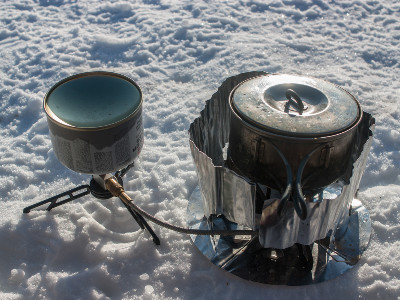
It is best to be able to have a hot meal at night and at least a warming cup of tea in the morning, and possibly to fill a flask for hot drinks through the day as well. In winter the weather often means itís best to do this in the shelter of the tent porch, but safety and ventilation are crucial. Some tent porches are too small to allow safe use of a camping stove, so make sure you have enough space.
If you have a gas stove, make sure youíre using a butane/propane mix Ė butane alone doesnít work well in the cold. In any case, keep the gas cylinder out of contact with snow or cold ground; it will work more efficiently.
The next thing is to keep cooking time to a minimum, because itís going to cause condensation inside your flysheet and perhaps inside the tent inner as well. Unless thereís a big storm leave the porch door zip undone from the top if your tent allows this and place the stove below this so steam can escape.
If you have to cook outside the cover of your tent then make sure your stove is sheltered and that youíre wearing enough spare clothes to ensure you donít get wet or chilled.
The basics remain the same no matter the season. And don't just dig a hole in the snow when you poo, because when the snow melts your deposit will still be there.
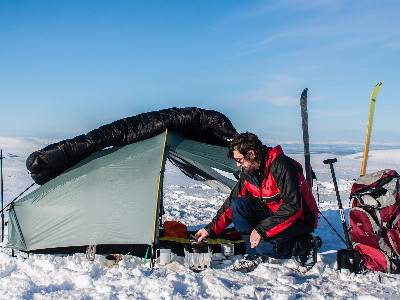
For winter youíll need a good sleeping bag, but you also have to think about bulk and weight. Sleeping bags are Ďratedí, one, two, three, four seasons. Traditionally, down sleeping bags would offer the best insulation for the least bulk and weight. But down, when damp/wet, loses its insulation properties. A sleeping bag is a big investment, so donít rush into it. Thereís an excellent article on the factors you should consider on the ukclimbing website.
Because youíll be camped on cold ground or snow, what you sleep on becomes as important as what you sleep in. There is plenty of choice in sleeping mats, from simple foam pads to down-filled airbeds and you will have to balance the usual factors Ė weight, bulk and cost Ė as well as just looking at the insulation properties. An experienced companion or a good shop will be able to advise.
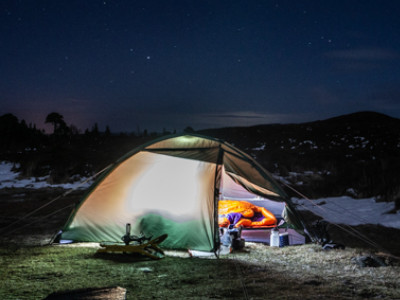
There can be more to keeping warm than just crawling inside that five-season bag. A good bag will have at least one drawcord to keep the heat in. Use this: a lot of heat can be lost out of the mouth of the sleeping bag. You should also be able to draw the hood around your head so that only your eyes, nose and mouth are uncovered, but if this feels claustrophobic, at least wear a fleece or woollen hat in bed Ė itíll make a big difference to how warm your whole body feels.
If youíre doing anything in the tent which requires your arms to be free for any length of time, pull the drawcord snug under your armpits. That avoids losing more body heat from inside the bag, and you can always pull on a down jacket to keep your arms and shoulders warm too.
Keep your (dry) clothes on inside your sleeping bag if itís cold. The old tale of sleeping warmer naked in a sleeping bag is simply untrue.
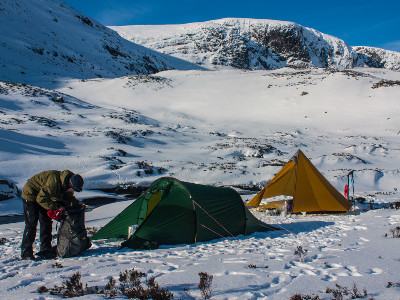
Donít be too eager to get out of that bag in the morning (unless itís to answer a call of nature!). You may be able to cook and eat breakfast and even start packing your rucksack before leaving the warmth of your bag.
Remember, if it was cold through the night then the morning will be bitter, so keep as warm as you can right up until youíre going to start moving and can generate more warmth through movement.
When you do leave the warmth of the bag, know exactly what youíre going to do: get dressed immediately in your clothes and footwear for the day, finish packing everything into your rucksack and take down and pack away your tent. This should be a well-rehearsed sequence of events and you should be able to be on the move within minutes, because the longer you spend packing the colder youíll get.
Top tips: Use an already wet pair of gloves to pack your rucksack, as stuffing a cold/wet/icy tent into your rucksack will soon wet a lovely dry pair.
And wear your insulated jacket until youíre ready to set off and then stuff
it in the top of the pack so itís available for rest stops.